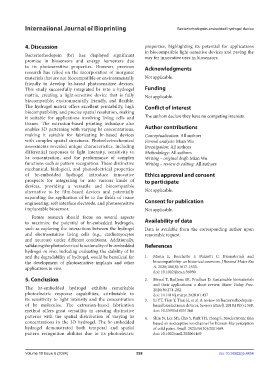Page 536 - IJB-10-6
P. 536
International Journal of Bioprinting Bacteriorhodopsin-embedded hydrogel device
4. Discussion properties, highlighting its potential for applications
in biocompatible light-sensitive devices and paving the
Bacteriorhodopsin (br) has displayed significant way for innovative uses in biosensors.
promise in biosensors and energy harvesters due
to its photosensitive properties. However, previous Acknowledgments
research has relied on the incorporation of inorganic
materials that are not biocompatible or environmentally Not applicable.
friendly to develop br-based photosensitive devices.
This study successfully integrated br into a hydrogel Funding
matrix, creating a light-sensitive device that is fully Not applicable.
biocompatible, environmentally friendly, and flexible.
The hydrogel matrix offers excellent printability, high Conflict of interest
biocompatibility, and precise spatial resolution, making
it suitable for applications involving living cells and The authors declare they have no competing interests.
tissues. The extrusion-based printing technique also
enables 3D patterning with varying br concentrations, Author contributions
making it suitable for fabricating br-based devices Conceptualization: All authors
with complex spatial structures. Photoelectrochemical Formal analysis: Mian Wu
assessments revealed unique characteristics, including Investigation: All authors
differential responses to light intensity, sensitivity to Methodology: All authors
br concentration, and the performance of complex Writing – original draft: Mian Wu
functions such as pattern recognition. These distinctive Writing – review & editing: All authors
mechanical, biological, and photoelectrical properties
of br-embedded hydrogel introduce innovative Ethics approval and consent
prospects for integrating br into various kinds of to participate
devices, providing a versatile and biocompatible
alternative to br film-based devices and potentially Not applicable.
expanding the application of br to the fields of tissue
engineering, soft interface electrode, and photosensitive Consent for publication
implantable biosensor. Not applicable.
Future research should focus on several aspects
to maximize the potential of br-embedded hydrogels, Availability of data
such as exploring the interactions between the hydrogel Data is available from the corresponding author upon
and electrosensitive living cells (e.g., cardiomyocytes reasonable request.
and neurons) under different conditions. Additionally,
validating the photoelectrical functionality of br-embedded References
hydrogel in vivo, including evaluating the stability of br
and the degradability of hydrogel, would be beneficial for 1. Marin E, Boschetto F, Pezzotti G. Biomaterials and
the development of photosensitive implants and other biocompatibility: an historical overview. J Biomed Mater Res
applications in vivo. A. 2020;108(8):1617-1633.
doi: 10.1002/jbm.a.36930
5. Conclusion 2. Biswal T, BadJena SK, Pradhan D. Sustainable biomaterials
and their applications: a short review. Mater Today Proc.
The br-embedded hydrogel exhibits remarkable 2020;30:274-282.
photoelectric response capabilities, attributable to doi: 10.1016/j.matpr.2020.01.437
its sensitivity to light intensity and the concentration 3. Li YT, Tian Y, Tian H, et al. A review on bacteriorhodopsin-
of br molecules. The extrusion-based fabrication based bioelectronic devices. Sensors (Basel). 2018;18(5):1368.
method offers great versatility in creating distinctive doi: 10.3390/s18051368
patterns with the spatial distribution of varying br 4. Shin N, Lee SH, Cho Y, Park TH, Hong S. Bioelectronic skin
concentrations in the 3D hydrogel. The br-embedded based on nociceptive ion channel for human-like perception
hydrogel demonstrated both temporal and spatial of cold pains. Small. 2020;16(30):2001469.
pattern recognition abilities due to its photoelectric doi: 10.1002/smll.202001469
Volume 10 Issue 6 (2024) 528 doi: 10.36922/ijb.4454

